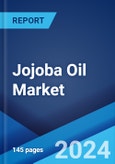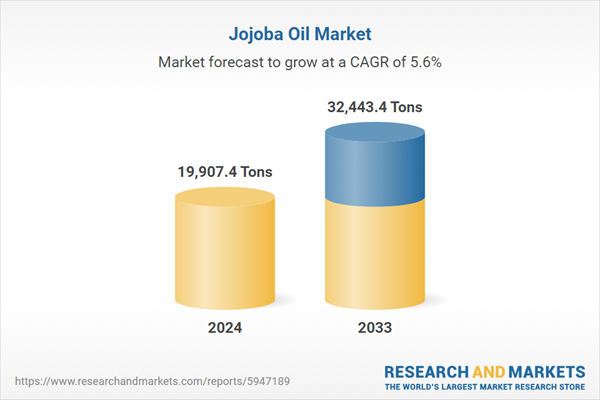The Rising Demand from the Cosmetic Industry Augmenting the Market Growth
The jojoba oil market has been experiencing continuous growth. Jojoba oil is widely used in various skincare and hair care products, such as facial cleansers, moisturizers, scar and stretch mark minimizers, anti-acne gels, hair conditioners, de-tangling creams, and hair regrowth serums. It is rich in essential vitamins and minerals like vitamins C, B, and E, copper, and zinc, making it an excellent nourishing agent for skin and hair. Moreover, as consumers are increasingly becoming conscious of the benefits of organic personal care products, the demand for jojoba oil is expected to rise further.Competitive analysis, such as market structure, future market growth, new entrants, and product differentiation, has been covered in the report. Also, detailed profiles of all major companies have been provided. The market structure is fragmented due to the presence of numerous large and small players. There is intense competition between vendors owing to low product differentiation and low switching costs. The volume of new entrants is moderate in the jojoba oil industry due to low product differentiation, high capital costs, and the requirement of the economy of scale for firms to remain profitable.
What is Jojoba oil?
Jojoba oil is a vegetable oil derived from the crushed beans of the jojoba shrub, scientifically known as Simmondsia Chinensis. This polyunsaturated liquid wax is structurally similar to sebum, the natural oil produced by the skin. Consequently, it has excellent skin absorption properties and rarely causes allergic reactions. In addition, it helps inhibit the growth of various bacterial and fungal microbes that attack the skin. It contains several essential vitamins and minerals, including vitamin E and B complex, silicon, chromium, copper, iodine, and zinc. It can nourish dry skin and regulate oil production while preventing skin damage due to microbial growth. As a result, jojoba oil finds extensive applications in skin care products as an ideal alternative to animal fats in the production of body creams and lotions across the globe.
COVID-19 Impact:
The COVID-19 pandemic outbreak has caused a severe problem for the jojoba oil industry and imposed unprecedented challenges on numerous countries. The supply of both raw materials, such as jojoba seeds, and finished products, like jojoba oil, has been interrupted in countries around the world due to the implementation of lockdowns. It has also created a serious disturbance in the packaging sector and hampered the supply chains, which resulted in shortages and increments in the price of raw materials. The pandemic has also resulted in labor shortages and led to inter-country trade bans. This, in turn, has forced jojoba oil manufacturers to reduce capacity utilization and even shut down plants due to the reduced availability of raw materials. However, the extent of the impact varies depending on the nature of the business. Industries such as tourism, aviation, and hospitality have been hit hard, while the COVID-19 outbreak has positively impacted sectors like pharmaceuticals, online education, and home fitness equipment. With increasing unemployment rates and lower incomes, people have restricted their spending to essential goods, resulting in decreased demand for luxury products like jojoba oil. Lower incomes have also caused people to be more cautious with their spending on luxury items. As jojoba oil is primarily used for cosmetic purposes, reduced discretionary spending on cosmetic items has further contributed to the decline in product demand. Additionally, the temporary closure of supermarkets, hypermarkets, and malls in various countries during the COVID-19 pandemic has also led to reduced consumer spending, thereby affecting the overall product demand.Jojoba Oil Market Trends:
At present, the rising use of jojoba oil in manufacturing personal care products represents the primary factor driving the market growth. Moreover, jojoba oil has remarkable shelf life and stability, as it resists oxidation, rancidity, and breakdown under high temperatures and pressure. In line with this, the increasing adoption of jojoba oil in various skin and hair care products, including moisturizers, facial cleansers, scar and stretch mark minimizers, anti-acne gels, hair conditioners, de-tangling creams, and hair regrowth serums is positively influencing the market growth. Additionally, the surging utilization of jojoba oil as a dietary supplement and a key ingredient in several pharmaceutical products that aid in treating sores, cuts, bruises, burns, athlete's foot, and warts has catalyzed the market growth. Besides this, key players are investing heavily in research and development (R&D) activities to develop innovative and cost-effective technologies to ensure a consistent supply of jojoba oil resources, which is acting as another major growth-inducing factor. Furthermore, jojoba oil possesses powerful anti-inflammatory properties that can help alleviate skin irritations such as chaffing, chapping, and redness caused by dryness. In addition, a rising number of people incorporating jojoba oil into their daily skincare routine to treat a range of skin issues, including acne, dryness, and scar removal, is contributing to the market growth. Other factors, including the growing awareness about the benefits of jojoba oil, escalating demand for organic personal care products, and inflating consumer disposable incomes, are also anticipated to drive the market further.Key Market Segmentation:
The publisher provides an analysis of the key trends in each segment of the global jojoba oil market, along with forecast at the global, regional, and country levels from 2025-2033. The market has been categorized based on application and distribution channel.Application Insights:
- Cosmetics
- Pharmaceutical
- Industrial
- Others
Distribution Channel Insights:
- Supermarkets and Hypermarkets
- Convenience Stores
- Online Stores
- Others
Regional Insights:
- Asia Pacific
- North America
- Europe
- Middle East and Africa
- Latin America
Competitive Landscape:
The report has also provided a comprehensive analysis of the competitive landscape in the global jojoba oil market.Some of the companies covered in the report include:
- Eco Oil Argentina SA
- Purcell Jojoba International
- Egyptian Natural Oil Co.
- Inca Oil SA
- The Jojoba Company
- Vantage Specialty Chemicals Inc.
Key Questions Answered in This Report
1. What is jojoba oil?2. How big is the global jojoba oil market?
3. What is the expected growth rate of the global jojoba oil market during 2025-2033?
4. What are the key factors driving the global jojoba oil market?
5. What is the leading segment of the global jojoba oil market based on application?
6. What is the leading segment of the global jojoba oil market based on distribution channel?
7. What are the key regions in the global jojoba oil market?
8. Who are the key players/companies in the global jojoba oil market?
Table of Contents
Companies Mentioned
- Eco Oil Argentina SA
- Purcell Jojoba International
- Egyptian Natural Oil Co.
- Inca Oil SA
- The Jojoba Company
- Vantage Specialty Chemicals Inc.
Table Information
| Report Attribute | Details |
|---|---|
| No. of Pages | 138 |
| Published | January 2025 |
| Forecast Period | 2024 - 2033 |
| Estimated Market Value in 2024 | 19907.4 Tons |
| Forecasted Market Value by 2033 | 32443.4 Tons |
| Compound Annual Growth Rate | 5.6% |
| Regions Covered | Global |
| No. of Companies Mentioned | 6 |









